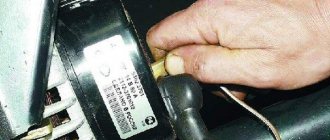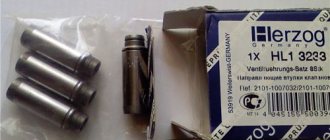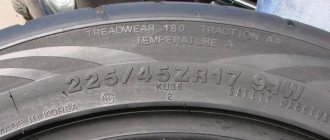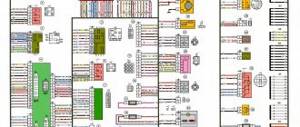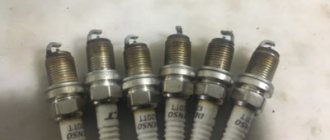It cannot be said that the VAZ 2114 is a very modern car filled with electronics. However, the list of sensors used that are connected to the electronic control unit is quite impressive on the fourteenth.
Each of these devices is responsible for certain functions and collects data transmitted to the main computer of the car. This way, the ECU controls the entire process and makes appropriate changes, so that the driver does not have to look for the reasons for the failure or insufficiently efficient operation of a particular unit.
From the material you will learn what sensors are installed on the VAZ 2114 (the information is also relevant for the VAZ 2113 and VAZ 2115), their locations, functionality and features of each device.
All VAZ 2114 sensors – which ones are there and what they are responsible for (list table)
Most of the units we are considering are located in the engine compartment. We present to your attention a diagram of the arrangement of sensors on the VAZ 2114 engine:
| Sensor name | What is he responsible for? |
| Coolant temperature sensor | Coolant temperature sensor or, in short, DTOZH , is a device that determines the temperature of antifreeze in the cooling system and gives a signal to reduce it by triggering the fan . |
| Idle speed sensor | The idle speed sensor (dhx), or more correctly called the “idle speed regulator” (irx) on the VAZ 2114 and on other Samara families is designed to stabilize and automatically adjust the idle speed. |
| Crankshaft sensor | This sensor is electromagnetic in principle. Thanks to it, the fuel injectors in the fuel injection system and the entire ignition system operate synchronously |
| Oil pressure sensor | The oil pressure sensor is primarily responsible for monitoring the oil, that is, it checks the pressure and in case of any problems immediately notifies the driver. |
| Camshaft sensor | The camshaft position sensor (CPS) is used to determine the angular positions of the timing belt in relation to the position of the crankshaft |
| Oxygen sensor | A lambda probe is an oxygen sensor that allows the electronic system to monitor and balance the correct ratio of air and gasoline in the combustion chambers. It is able to promptly correct the structure of the fuel mixture and prevent destabilization of the engine operating process |
| Throttle sensor | The throttle position sensor (TPS) is designed to transmit information to the electronic engine control unit about the exact state of the bypass valve at a given moment in time. |
| Knock sensor | Knock sensor (DD, knock sensor) - a sensor for determining the level of detonation during operation of an internal combustion engine, which is part of the group of sensors of the electronic engine control system (ECM) |
Air sensor VAZ-2114
Modern environmental requirements for internal combustion engines are increased. That is why, in all modes of its operation, the established ratio of air to fuel in the air-fuel mixture must be maintained.
Only if these conditions are met will the catalytic converter completely remove harmful substances in the exhaust gases.
To maintain the stoichiometric ratio of the various components present in the fuel-air mixture, reliably accurate information on the amount of air consumed is required.
The air flow sensor installed on the VAZ-2114 is designed to collect air flow data. The measure of intake air flow can be calculated both in volume and in mass.
Today there are two types of air flow sensor: thermal and mechanical.
With the mechanical method, the incoming air is measured, which is proportional to the movement of the damper. The basis of the thermal method is to measure the mass of incoming air, which directly depends on the temperature of the sensitive element for a given period of time. The car's air flow sensor is installed between the throttle valve and the air filter in the intake system.
Location of sensors VAZ 2114
Signaling devices called sensors are installed in order to inform the driver or some control device about changes occurring during the operation of the car or about the state of the corresponding unit or system, as well as to signal in case of failures or emergency conditions in the car. Therefore, the driver must have a good understanding of the operating principle and location of the sensors on the VAZ 2114.
- The oil level has dropped significantly;
- the oil filter is clogged;
- the oil pump has failed;
- oil pressure sensor is faulty;
- The wiring is faulty or the oil pressure has dropped due to leaks.
On an eight-valve engine, the sensor is located on the right side below the valve cover in the cylinder head. On a sixteen-valve engine - on the left end of the camshaft bearing housing.
Where is the coolant temperature sensor located on the VAZ 2114
For proper operation, ensuring the collection and transmission of optimally accurate indicators, the DTOZH must be located in direct contact with the measured medium, that is, it must be immersed in the coolant.
Let's look at a temperature sensor using the example of one of the cars in the Lada model range.
The cooling system of VAZ cars is a complex of the following parts:
- heating and cooling radiators;
- fan;
- pump;
- expansion tank;
- coolant temperature sensor.
The measuring device, located between the thermostat and the cylinder head, consists of a resistor and is connected to the control unit by two wires.
Determination of the heating level is based on the resistance value, which increases or decreases depending on the coolant temperature.
Important! The temperature detector on the VAZ 2114 is not located on the radiator, which is typical for other VAZ models, but on the engine block.
Where is the idle speed sensor located on the VAZ 2114
Many drivers and mechanics who are or have been involved in repairing this device know where the sensor is located and note its extremely inconvenient location. IAC VAZ 2114 is destined for a place of permanent registration on the body of the throttle device.
Therefore, you will have to put up with some inconveniences while working with it.
Where is the crankshaft sensor located on the VAZ 2114
It is not difficult to detect the shaft position sensor on a VAZ 2114. It is located under the hood near the crankshaft pulley and is attached to the oil pump with a bolt.
Where is the oil pressure sensor located on the VAZ 2114
Typically, on modern budget cars, the oil pressure sensor is installed in the engine compartment on the rear side, closer to the air filter. Where the VAZ 2114 oil pressure sensor is located can be seen in the screenshot below.
The design of the sensor is more than primitive: a measuring membrane and a transmitter are placed in a metal case. The oil presses on the membrane and, if necessary, a warning signal is sent to the control lamp.
Where is the camshaft sensor located on the VAZ 2114
The phase sensor operates on the principle of an elementary Hall sensor. Installed only in the camshaft area on both 8 and 16 valve engines. The device reads data from the engine camshaft using a gear mounted on the shaft with two missing teeth. These two teeth are positioned so that every time the device is hit, the first piston of the engine is at top or bottom dead center. Information signals about the location of the camshaft are sent to the engine control unit, which, in turn, monitors and changes the ignition angle. It began to be used at VAZ factories on the first cars with distributed fuel injection.
It is worth noting that carburetor engines do not have this unit, because their ignition timing system is vacuum-mechanical.
The main function of the camshaft position DF or phase sensor is to constantly adjust the ignition angle while the engine is running. Thanks to its use, VAZ family engines began to transmit power more efficiently with reduced fuel consumption. The main indispensable use of the phase sensor remains for two camshaft, 16-valve engines, which without it cannot operate evenly and economically according to the folded factory design.
Where is the oxygen sensor located on the VAZ 2114
On different engines it is located in different places, namely on the very first cars with a 1.5 engine, there was only one sensor installed and it is located on the very exhaust pipe of the car, at the very bottom of the car, for example, see the photo below in which this sensor is indicated by an arrow:
Now, regarding cars with a 1.6 engine, on these engines, in order to see the oxygen sensor, you no longer need to crawl under any car, you can just open the hood and you will immediately see it, the whole point is that this sensor is not located on the exhaust pipe of the car as on the 1.5 engine and it is immediately screwed into the exhaust manifold (in the photo below it is indicated by a red arrow), but in addition to this sensor, look carefully you may have another exactly the same sensor (in the photo it is indicated by a blue arrow)
Where is the throttle sensor located on the VAZ 2114
Injection engines required the installation of a large number of automatic devices that regulate and monitor the activities of all power plant systems. The drive principle of one of the main mechanisms regulating the fuel supply to the engine - the throttle valve - has changed. The drive became electric, electronically controlled. Its difference from mechanical is as follows:
- there is no mechanical connection between the gas pedal and the throttle valve itself;
- Idle speed is regulated by moving this very damper.
Since there is no longer a rigid connection between the pedal and the damper, all control is carried out through the operation of electronic systems. In this scheme, along with the control unit, the throttle sensor plays an important role.
The device itself is installed on the same axis with the throttle valve. It works like a potentiometer:
- One output of the sensor receives a 5 V electrical signal, the opposite is connected to ground. The third channel, from the moving contact, sends an electrical signal to the controller. When the damper is turned, the voltage coming from the current collector slider to the output changes;
- when the ignition is turned off, you can measure the voltage supplied to the TPS using a measuring device. To do this, you need to install the probe needles on the input contact and ground. If the throttle valve is closed, then the tester should show no more than 0.7 V and no less than 0.5 V. When the engine is running, the voltage should increase as the valve opens and, at its maximum open position, show 4 V (+0.3);
- when the throttle valve opening angle changes, the voltage going to the controller from the TPS slider changes and it regulates the fuel supply;
- TPS is associated with the operation of the idle speed control device (IAC). At startup, if the damper is in the closed position, then when the controller receives such a signal from the sensor, it connects the IAC and additional air flows into the engine, bypassing the closed damper.
The performance of the TPS must be monitored by measuring the resistance using an ohmmeter. To do this, the device is connected to the input and output contacts of the sensor. When you press the gas pedal, there should be a smooth change in resistance, but if the device shows zero or the resistance goes to infinity, this indicates a malfunction of the TPS on the VAZ 2114.
Where is the knock sensor of the VAZ 2114 located?
It is located between the second and third cylinders on the engine block (if viewed from the radiator side). Its location from the point of view of providing simple, unobstructed access is conveniently implemented in eight valve engines. But in more complex engines (16 valves), some inconvenience appears. This is due to the high density and accumulation of units in the engine compartment.
Speed sensor VAZ-2114
This type of sensor is an excellent driver assistant, constantly transmitting information about the current vehicle speed while driving. This sensor is located on the gearbox and simultaneously produces six pulses per meter of vehicle movement.
The main element is a disk mounted on the internal axis of the sensor, with a multi-pole magnet located nearby. Today there are two types of sensors: pass-through and non-pass-through.
The installation of the pass-throughs is carried out at the break in the cable fastening, which activates the speedometer needle. Installation of non-pass-through ones is carried out on vehicles with an electric instrument cluster.
Common malfunctions of VAZ 2114 sensors
Let's briefly and essentially touch on the malfunctions of each sensor in the electronic engine management system. VAZ 2114
| Sensor | Causes of breakdowns | Symptoms of malfunction | Examination |
| Mass air flow sensor - mass air flow sensor | Contamination, torn film due to sucked-in dust. | If the readings are greater than 1.07V, then the sensor must be replaced. | We check the parameters of the channels of the analog-to-digital converter or measure the voltage between 3 (mass of the mass air flow sensor) and 5 (signal) contacts using a multimeter. |
| DC - oxygen sensor or Lambda Probe | Poor quality fuel, mechanical damage to the sensor, faulty injectors. | Increased exhaust toxicity, increased fuel consumption and Check Engine activation. | The causes of breakdowns can only be determined by computer diagnostics of the car. |
| DTOZH – coolant temperature sensor | Lack of contact with the sensor, broken contact. | Turning on the fan unnecessarily, increasing gasoline consumption, a warm engine refuses to work | |
| TPS – throttle position sensor | Oxidation of contacts, wear of sensor substrates. | High idle speed, significant reduction in engine power. | Smoothly squeezing the gas pedal, monitor the readings of the percentage opening of the damper; the voltage should also change smoothly without drops; if the voltage on the multimeter fluctuates, the sensor must be replaced. |
| DPKV – crankshaft position sensor | Broken wires, dirt getting between the sensor and the gear disk. | A sharp decrease in the car’s power, which can be determined even without special instruments, involves an arbitrary decrease or increase in engine speed; | Measure the resistance of the sensor winding; if there are deviations from the norm of 550-750 Ohms, the sensor must be replaced. |
| DS – vehicle speed sensor | Open circuit in contacts, corrosion and dirt on contacts. | Problems with idle speed | Computer diagnostics only. You can independently monitor the proper operation of the sensor using the BC and the standard speedometer. |
| DF – phase sensor | Metal particles and dirt on the sensor | Instead of starting the engine immediately, the system waits for the DPKV counter readings and the Check Engine signal turns on, gasoline consumption increases, and engine dynamics decrease. | Carried out using an oscilloscope |
Crankshaft sensor VAZ-2114
The crankshaft sensor is installed on the oil pump cover at a minimum distance from the drive disk of the mechanism. Information coming from the position meter in which the crankshaft is located is received by the engine control system, through which the injection and ignition system is controlled.
You can replace almost all types of sensors installed on a VAZ-2114 car yourself, with your own hands; for this it is not necessary to take the car to a car service center. Watching the video will give you a clearer idea of the idle speed sensor.
